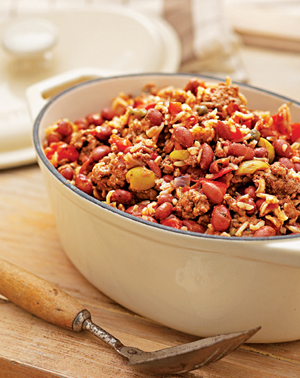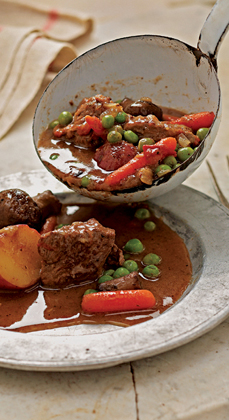

Venison Stew
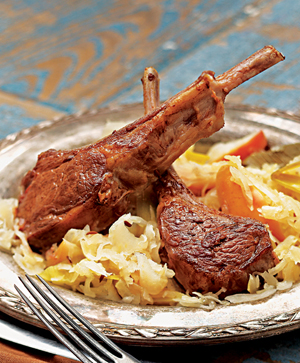
Lamb Chops and Sauerkraut

Simple Side: Vinaigrette Salad
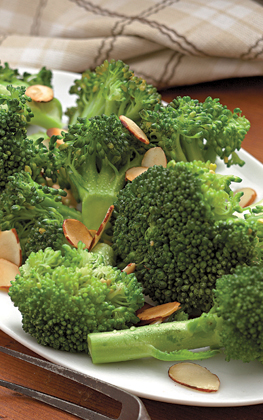
Simple Side: Steamed Green Veggies and Nuts
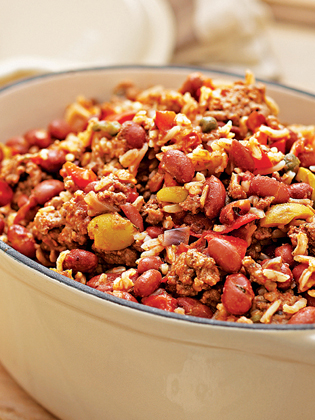
Red Beans, Brown Rice, and Lean Beef
258 Simple Side: Steamed Green Veggies and Nuts
262 Simple Side: Vinaigrette Salad
264 Red Beans, Brown Rice, and Lean Beef
EACH OF the three delightful meals in this chapter is hearty, satisfying, and complete—minus, of course, the dessert! (But feel free to add a few squares of dark chocolate and a glass of red wine to make the evening complete.) The main one-pot meal is protein-based and relatively easy to prepare, and will feed a family nicely. Though this is the one-pot chapter devoted to meat-based dishes, you can prepare the third meal—red beans and rice—as a meatless dish. Simply leave out the beef or turkey. It still tastes great.
The first meal, Lamb Chops and Sauerkraut, features a meat we haven’t talked about so far. Lamb is a staple in countries throughout the world, especially in the Middle East and the Mediterranean. It’s also common in New Zealand and Australia. Technically the term “lamb” is reserved for the meat of a domestic sheep a year old or younger. (Older sheep are called either hogget or mutton.)
I’ve talked elsewhere in this book (see page 49) and also in The 150 Healthiest Foods on Earth about the benefits of grass-fed meat. In a perfect world, you wouldn’t eat any other kind. (I know this isn’t a perfect world, and if you need to eat “regular” meat, so be it, but I feel strongly about the quality of the meat we eat when we do eat meat and want to let you know why.) Point is, it’s kind of moot when it comes to lamb, because lamb by definition is young (sometimes as young as one month), and it is almost always raised on pasture. And it’s just not popular enough here in the United States for the big agribusinesses to have bothered to figure out a way to “factory farm” lamb. Hence it’s a meat that—as far as I know—is usually free from steroids, hormones, and extra antibiotics.
Like beef, lamb is a great source of protein; one 4-ounce (115-g) loin chop has 27 g. Also like beef, only about half the fat is saturated; the other half is monounsaturated, the same kind that’s in olive oil. One loin lamb chop also has about a third of the Daily Value for B12, about 40 percent of the daily value for niacin, and just under 25 percent of the Daily Value for zinc. You can get the chops in either loin or rib. The rib is a little higher in calories and fat and a little lower in protein.
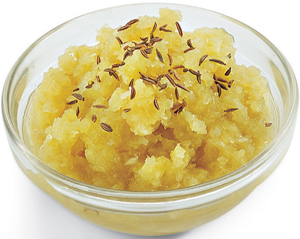
One of my favorite superfoods in the Lamb Chops and Sauerkraut is apples. I’ve raved about apples earlier in this book (and, of course, in The 150 Healthiest Foods on Earth), but just to recap, they’re loaded with an important member of the flavonoid family called quercetin, which is known for its anticancer activity as well as for being a powerful anti-inflammatory. One medium apple also has 3 g of fiber, much of it from pectin, which has been shown to lower both cholesterol and glucose (sugar) levels in humans. In a recent (August 2007) study at the University of Georgia, prostate cancer cells exposed to pectin under laboratory conditions were reduced in number by up to 40 percent. And the apples in this dish are cooked; interestingly, University of Georgia research found that the anticancer properties of pectin increased significantly when it was heated. Remember to buy organic apples, because apples are at the top of the list for heavy pesticides.
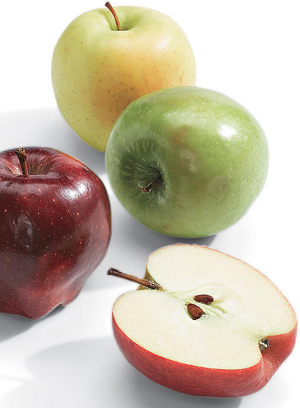
FERMENTED FOODS
Another great food in this meal is sauerkraut. It’s superb, especially when it’s prepared the traditional way. Why? Because it pairs cabbage—one of the healthiest foods on Earth—with one of the most healthy forms of processing on the planet: fermentation. The result is a superfood that’s absolutely loaded with healthy bacteria called lactobacillus, which improve digestion, immune function, and the absorption and assimilation of nutrients.
I’m a huge fan of naturally fermented foods. Fermentation is an ancient technique of preparation and preservation in which food is naturally “processed” by microorganisms such as bacteria that break down the carbohydrates and protein in the food. Unfortunately, commercial food processors have tried to standardize the fermentation techniques, and many modern mass-produced foods (such as canned olives and pickles) are not actually fermented. They’re just treated with chemicals, packed in salt, and canned. That’s not what you want. Only authentic fermentation gives you the amazing health benefits of the live cultures such as lactobacillus, which offer wonderful benefits to the immune system and to digestion. These live cultures also help control inflammation, which is a central feature of so many degenerative diseases, including heart disease. And active cultures can actually suppress H. pylori, which is the type of bacteria responsible for most cases of ulcers.
Besides having the advantages of containing live cultures, sauerkraut also brings to the table all the wonderful nutritional and health benefits found in the original food used to make it—cabbage. I’ve written elsewhere (see page 155) about the amazing benefits of cabbage (and its relatives in the Brassica family), but just to remind you, cabbage is high in a group of plant compounds called indoles that have demonstrated anticancer activity. Cabbage plus fermentation equals a health bonanza.
Another supporting player in this one-pot cast of characters is leeks, which add a delicious flavor to the mix and also contain a whole pharmacy of compounds with health benefits, including thiosulfinates, sulfides, sulfoxides, and other sulfur compounds. The active substances in leeks, including allyl sulfides, help provide protection against cancers by blocking the action of hormones or chemical pathways within the body that promote cancer. Regular consumption of allium vegetables—the family to which leeks belong—is associated with a reduced risk of both colon and prostate cancers.
Great Herbs and Spices for Red Meat
Beef: Bay leaf, bouquet garni, caraway seeds, chives, cinnamon, coriander (ground), cumin, fennel, green peppercorn, horseradish, mace, marjoram, mustard, oregano, paprika, savory, and thyme
Lamb: Allspice, basil, coriander (ground), fines herbes, marjoram, mint, mustard, oregano, parsley, rosemary, sage, savory, and tarragon
Venison: Bay leaf, caraway seeds, fines herbes, ginger, green peppercorn, horseradish, juniper berries, mace, marjoram, mustard, sage, and savory
VENISON: NO NEED TO HUNT FOR ITS MINERALS
Okay, I feel exactly the same way you do. Tell me “venison,” and I think “Bambi.”
I remember many conversations about venison back during the twelve years I was the iVillage.com weight loss coach. Whenever anyone would mention eating venison, I’d cringe, until one of my valued and respected message board moderators finally did the cyber equivalent of “pulling me aside” and explained that she—and many people across the country—hunt and eat deer for food, not for sport. She explained that where she came from, people relied on deer to provide meat throughout the winter, freezing the steaks, and living on them for months. Her attitude toward these gorgeous animals was similar to that of the Native Americans. She respected and appreciated the animals that gave their lives so that she and her family could eat. She too loved Bambi, but deer was an important part of her diet.
I admit it, I’m still a bleeding-heart liberal, but I’ve come to appreciate what an amazingly healthy and nutritious meat venison is. It’s even delicious in recipes like this Venison Stew. Venison is packed with protein, vitamins, and minerals, such as phosphorus, potassium, zinc, and iron. And if it’s caught in the wild, venison is free of antibiotics and synthetic hormones.
Venison also has less fat and calories than beef. According to Charles J. Alsheimer in the September 2000 issue of Deer & Deer Hunting, deer accumulate most of their fat around their organs and in single layers, typically atop muscle and underneath the hide. These fat layers can be easily removed during the butchering process. Whitetails also have less fat in their muscle tissues because they are constantly exercising. Indeed, all cuts of deer meat are extremely low in fat.
My friend Regina Wilshire, N.D., who contributed this recipe and many ideas for this book, is responsible for the suggestion that we use a couple of tablespoons of flour in this venison recipe. Here’s why: The flour acts to protect the meat from forming nasty compounds appropriately nicknamed AGES, which stands for advanced glycation end-products. AGES result from protein being browned or caramelized when it comes into contact with high-sugar or carbohydrate foods. (Nutritionist Heather MacLean Walters, Ph.D., wrote an entire book on the health dangers of AGES, interestingly called The Body Browning Effect.) So that’s why the flour is there. Thanks, Regina.
PRODUCE POWER
If you’re familiar with my previous writing or with my philosophy about food and health at all, you probably know I’m no fan of potatoes. So no one was more surprised than I was when I recently read that Agricultural Research Service plant geneticist Roy Navarre, Ph.D., and his colleagues at Washington State University and Oregon State University identified sixty different kinds of phytochemicals and vitamins in the skins and flesh of 100 wild and commercially grown potatoes. According to Navarre, the number of phenols, which are plant chemicals with health benefits, found in red and Norkotah potatoes rivals that of broccoli, Brussels sprouts, and spinach. I’ll be honest: I’m not completely convinced—yet. But at least I don’t feel so bad about including potatoes in the Venison Stew one-pot meal. Besides, I never said they didn’t taste great.
Braising and Healthy Cooking
Braising is a cooking method usually used for tougher cuts of meat, such as pot roasts, rumps, shanks, and ribs, and sometimes for vegetables. The food cooks in liquid, similar to stewing, which results in very tender meat. For best results, make sure that each piece of meat, or vegetables that you are braising, is similar in size. Most braised dishes take from 45 minutes (for smaller cuts of meat and poultry) to 6 hours (for really tough shanks and ribs). Here’s how to do it.
1. Heat a little oil in a heavy frying pan.
2. Season the meat or vegetables with salt and pepper, or with whatever seasonings you will be using.
3. When the pan and oil are hot, add the meat or vegetables and sauté them at medium-high—hot enough to brown the meat but not hot enough to destroy the essential fatty acids in the oil. This will add color and flavor.
4. Once browned, add enough liquid to the pan to come about halfway up the sides of the meat or vegetables. Liquid used for braising is usually water, stock, wine, or a combination.
5. Lower the heat and let the recipe simmer slowly or place the whole pan (ovenproof, of course) in the oven and bake it. Do not allow the liquid to evaporate.
6. If you want to use the braising liquid as a sauce, leave the pan uncovered so moisture can evaporate, thus concentrating the flavors. If you wish, add other ingredients to flavor the liquid along the way, such as vegetables or herbs and spices. Also, only do this with cuts that take less than 90 minutes or so to cook. Otherwise, just cover the pan.
7. When you’re braising, make sure the liquid level doesn’t get too low, or you’ll be baking and not braising. On the other hand, make sure the liquid level doesn’t get too high. If the liquid covers the meat and vegetables entirely, you’ll be stewing and not braising. Either way, the results will be totally different.
Also featured in the stew’s cast of ingredients are our old healthy staples onions and garlic, which are both members of the allicin family, and both foods that have consistently been associated with reduced rates of cancer and heart disease. Add in the mushrooms and spices and you’re good to go. According to Wilshire, calorie for calorie crimini mushrooms are superdense with nutrients, providing selenium, riboflavin, copper, niacin, pantothenic acid, phosphorus, and zinc. They’re ridiculously low in calories, so by definition they can’t provide a lot of all those nutrients, but the calories they do contain are far from empty!
BEANS AND RICE: PERFECTLY COMPLETE
Our third one-pot meal can be a chameleon. You can make Red Beans, Brown Rice, and Lean Beef with beef, turkey, or no meat at all. Like the old commercials for breath mints (“two, two, two mints in one!”), it’s a double bargain: a protein-packed vegetarian meal or a traditional meat-based dish. Either way it’s hearty, satisfying, and nutritious.
Like all beans, red beans are fiber heavyweights. High-fiber diets are associated with lower risk for a host of diseases, including heart disease and diabetes. As I’ve said many times before, Americans just don’t get enough of this important dietary necessity. All the major health organizations recommend between 25 and 38 g of fiber a day. Our Paleolithic ancestors got at least 50 g a day, but today the average American gets about 8. Not good. Just recently, researchers from the University of Massachusetts Medical School found that people eating a high-fiber diet were 63 percent less likely to have elevated levels of C-reactive protein, a measure of inflammation that can be an independent predictor of both diabetes and heart disease. Beans are a superb way to get fiber in your diet, and this one-pot dish is a great way to eat beans!
For years we’ve heard about the “complete” protein formed by rice and beans. Here’s the story: Protein is actually made up of molecules called amino acids, of which there are about twenty that are used by the cells to assemble proteins in the body (like muscles, bones, neurotransmitters, and hormones). These amino acids are conventionally divided into two groups: essential and nonessential. The terminology is misleading because all amino acids are essential and important. Many of them can be made in the body from other molecules, and they’re called nonessential. Those that can’t be made in the body from other molecules are called essential, meaning it’s essential that we get them from the diet.
When nutritionists talk about a “complete” protein, they mean a protein that provides all of the essential amino acids. Most vegetable sources don’t, though there are exceptions, such as spirulina and quinoa. But by eating a variety of vegetable sources, you can get all the essential amino acids. Rice and beans is the most typical example of a combination that provides a “complete” protein from plant sources.
Nutritionists have debated for decades about how to rate different kinds of protein for quality. Many believe that only animal foods provide the highest-quality protein, and there’s some data to back that theory up. However, other compelling data shows that you can get all your amino acids from vegetable sources. You can avoid the whole debate by using both! This dish is equally tasty with some beef or turkey, but if you prefer, you’ll get a fine amount of protein with just the rice and beans. Your choice.
Most people believe that white rice is the least “good” of the rices, being a basically nutritionally empty food with little fiber or nutrients. But unfortunately the differences between the rices are not as great as we’d like to think. All the rices are pretty high on the glycemic rating, meaning they raise blood sugar fairly quickly (not a good thing). But when you mix rice with beans, vegetables, and the optional meat, the glycemic impact of the meal is substantially blunted, and the impact on your blood sugar much more moderate. Neither brown nor white rice is a vitamin heavyweight. Where brown rice edges out white is for fiber. Brown rice has 3.5 g of fiber per cup, as opposed to a measly 1 g for white rice. Many Eastern cultures highly value rice as a gentle and natural detoxifier. It is very easy to digest, especially if well chewed, and when eaten in small amounts over time is said to calm and soothe the digestive system.
Our old friends onion and garlic add cancer-fighting plant compounds, and the olive oil provides heart-healthy monounsaturated fat. Tomatoes, especially when cooked, provide lycopene, which is an important antioxidant and member of the carotenoid family. The red bell pepper is rich in vitamins C, A, and K and the mineral potassium, as well as a super member of the carotenoid family—beta-cryptoxanthin—which may lower the risk of developing lung cancer. And the hot pepper is also rich in nutrients, plus it contains an active ingredient called capsaicin that enhances circulation and may also help aid digestion. And capsaicin depletes something called substance P, a chemical that transmits pain messages to the brain.
Even the oregano used for seasoning in this dish is a health food! According to some research, it has forty-two times more antioxidant activity than apples, thirty times more than potatoes, twelve times more than oranges, and four times more than blueberries. Plus the essential oil of oregano contains two compounds—thymol and carvacrol—that have antifungal, antibacterial, and antiparasitic properties, and one compound—rosmarinic acid—that has antimutagenic and anticarcinogenic properties. It’s no wonder Cass Ingram, D.O., called his book about oregano The Cure Is in the Cupboard!
To each of the one-pot meals, don’t forget to add the greens, and have a square of dark chocolate on me!
Enjoy!
The Best Way to Cook Game Meat
Whether you are cooking venison, buffalo, or some other type of exotic game meat, keep in mind that the meat will naturally be leaner—and therefore tougher—than farm-raised fatty cows and chickens, so cooking temperatures and seasonings will vary. Venison, buffalo, and elk have the consistency of beef but a lot less fat and therefore must be cooked medium to medium-rare.
Here’s how.
First, trim off as much fat as you can, because fat is one of the factors that gives game meat that “gamey” taste. For cooking quickly, sear the meat on both sides at a high heat (just enough to brown the sides). Next “lard it” by placing bacon over the top of it, which will keep the juices in, then cover it and place it in the oven. (If the taste of bacon seems too strong, other options for larding are butter and olive oil, which will also seal in juices.) Cook the meat until the internal temperature reaches about 135°F (57°C). Anything higher than that will dry out the meat and turn it to leather.
If you are slow-cooking the game, season it first with whatever you’d like, but leave out the salt, because that will dry out the meat. Lard it again with a few strips of bacon and place it in the oven at about 225°F (107°C). Let the meat cook for 8 to 16 hours. This process will produce a very tender piece of game meat.
Powerful protein and a cancer-fighting sidekick
Prep Time: 15 minutes
Cook Time: 4 hours (on high); 6-7 hours (on low)
Ingredients
6 to 8 small loin or rib lamb chops, ½ inch (1 cm) thick
1 teaspoon almond oil
2 medium leeks
3 cups (675 g) sauerkraut, drained
¾ cup (175 ml) low-sodium fat-free chicken broth
⅛ teaspoon garlic powder
1½ teaspoons caraway seed
½ teaspoon thyme
½ teaspoon salt
¼ teaspoon ground black pepper
2 apples, cored and sliced
Trim all of the visible fat off of the edges of the lamb.
In a skillet, heat the oil over medium-high heat. Carefully pour or wipe excess oil from the pan. Briefly sear each side of the lamb and set aside.
Cut most of the tough greens off the tops and about ½ inch (1 cm) of the bulb off the bottoms of the leeks. Slice the leeks lengthwise down the middles and cut them into 1-inch (3-cm) sections. Immerse the leeks in a sink of water and separate them to clean thoroughly. Drain the leeks and place them in a slow cooker, covering the bottom.
In a small bowl, whisk together the sauerkraut, broth, garlic powder, caraway seed, thyme, salt, and pepper. Pour half of the mixture over the leeks. Place the lamb on top and pour the remaining half of the mixture over the lamb. Top with the apple.
Cover the slow cooker and cook on low for 6 to 7 hours or on high for 4 hours.
Yield: 4 servings
• In the past, you could only buy fresh lamb during the spring or summer; hence the term “spring lamb.” But because lamb is now available year round, the term “spring lamb” doesn’t mean much anymore.
• Lamb is very perishable. Honor the “use-by” date, keep it in the original packaging until you use it to minimize exposure to air, and keep it cold or frozen.
• Brown the lamb chops first on the stovetop to give them a nice seared surface, because that won’t happen in a slow cooker. It’s not quite as important for skinned poultry, but it really helps the flavor of red meat cuts.
• If you freeze lamb, make sure to wrap it tightly. With proper freezing, it should keep for at least a few months.
• Loin lamb chops are less fatty than rib chops. Two chops generally yield about 4 ounces (115 g) of lean meat. Lamb has less marbling than other red meats, so if you trim the visible fat on the outside of the chops, you’ll remove most of it from the cut.
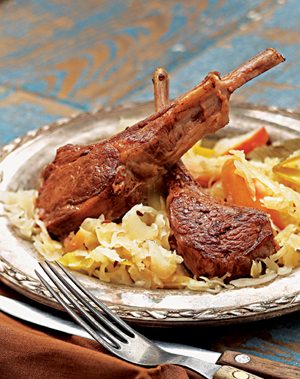
A frenzy of folate and good fat
Prep Time: 5 to 10 minutes
Cook Time: 3 to 10 minutes
Ingredients
4 cups (280 g) asparagus, young green beans, or broccoli florets, washed and trimmed
¼ cup (30 g) dry-roasted nuts, chopped, such as almonds, walnuts, or pecans
Fit a large pot with a steamer basket, pour water into the pot to just under the basket line (so it doesn’t come in direct contact with the veggies), and bring the water to a boil. Add the vegetables and steam until bright green and tender-crisp, for 3 to 10 minutes. Sprinkle the nuts over top and serve.
Yield: 4 servings
• Steaming plain green vegetables is a wonderful, simple way to prepare them. The light cooking brings their color up and makes them easier to digest. To steam green vegetables, place a steamer basket in a large saucepan with water to just under the basket line (so it doesn’t come into direct contact with the veggies). Bring the water to a boil and place the washed, trimmed vegetables in the basket. To retain more nutrients, cook them for the shortest amount of time. Broccoli can be ready in about 3 minutes, thin asparagus in about 6 minutes, and very fresh green beans in about 7 to 10 minutes. In general, the older or thicker a vegetable is, the longer it will need to steam properly.
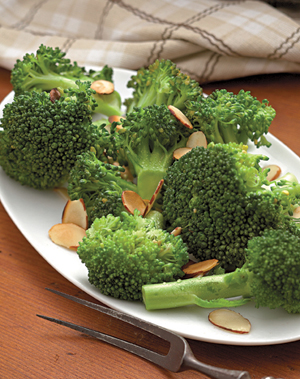
Lean protein and nutrients galore
Prep Time: 20 minutes
Cook Time: 1 hour 30 minutes
Ingredients
3 pounds (¼ kg) venison, cut into 1½- to 2-inch (4- to 5-cm) chunks
2 tablespoons (15 g) whole wheat flour
1 teaspoon salt, plus more or less to taste, divided
1 teaspoon ground black pepper, plus more or less to taste, divided
5 tablespoons (70 g) butter, divided
1 teaspoon dried thyme
2 tablespoons (28 ml) extra virgin olive oil
2 onions, finely chopped
2 large cloves garlic, minced
½ cup (120 ml) dry white wine
1½ cups (355 ml) low-sodium beef broth
⅓ cup (80 ml) Worcestershire sauce
1 tablespoon (5 g) lemon zest
1 bay leaf
1 cup (180 g) tomatoes, seeded, peeled, and coarsely chopped
1 cup (130 g) baby carrots
1 pound (455 g) small red baby potatoes, halved
1 pound (455 g) fresh whole crimini mushrooms
¾ cup (33 g) frozen green beans or baby peas, thawed
2 tablespoons (8 g) fresh parsley, chopped
Preheat the oven to 500°F (250°C, gas mark 10).
Pat the venison dry with paper towels.
Place the flour, salt, and pepper to taste in a resealable plastic bag. Place the venison in the bag and toss to coat with the flour.
In a heavy cast-iron skillet, heat 3 tablespoons (45 g) of the butter until bubbling, then add the venison 6 or 7 chunks at a time. Brown the venison carefully on all sides, then transfer it to a 4- to 5-quart (4- to 5-L) Dutch oven. When all of the venison is browned, discard the browned butter, wipe the skillet, and set it aside.
Toss the thyme with the venison. Place the Dutch oven, uncovered, in the oven and cook the venison, turning once after 5 minutes, for about 10 minutes, or until the meat is slightly crusted. Remove from the oven and reduce the oven heat to 325°F (170°C, gas mark 3).
In a skillet, heat the oil over low heat. Add the onions and cook for 5 minutes. Add the garlic and cook for about 5 minutes more, or until the onions have softened and browned a bit. Increase the heat to high. Add the wine and broth and bring to a boil. Boil for 3 minutes, then pour into the Dutch oven over the venison. Add the Worcestershire sauce, lemon zest, bay leaf, 1 teaspoon salt, and 1 teaspoon pepper and toss together.
Add the tomatoes, carrots, and potatoes and toss together. Cover the Dutch oven and bake on the middle shelf of the oven for 1 hour, or until the venison is fork-tender.
While the stew is cooking, melt the remaining 2 tablespoons (28 g) butter. Add the mushrooms and toss them in the butter, turning them frequently with a spoon until tender, about 10 minutes.
When the venison is done, add the mushrooms and liquid accumulated with the mushrooms to the Dutch oven along with the green beans or peas. Continue cooking the stew for another 10 to 15 minutes. Remove the Dutch oven, uncover, and, working against the side of the pot, ladle the sauce into a saucepan and remove as much fat as possible (from the sauce). Bring the sauce to a boil, reducing it by half. Taste for seasoning, then pour the sauce over the venison and mix together again. To serve, garnish with the parsley.
Yield: 6 to 8 servings
Notes from the Kitchen
• This Venison Stew takes some time and attention, but the layered cooking techniques and richness of the resulting flavors nicely mellow any gaminess of the venison.
• As an alternate to the red potatoes, try using 1½ cups (350 g) butternut squash cut into 1½-inch (4-cm) cubes, roughly the size of the potatoes.
• If you aren’t in a hurry, another way to efficiently defat a stew sauce like this one is to put the separated sauce and stew into the refrigerator overnight. When ready to serve, remove the congealed fat from the sauce, put the stew on the stovetop to warm, and follow the directions to complete the recipe.
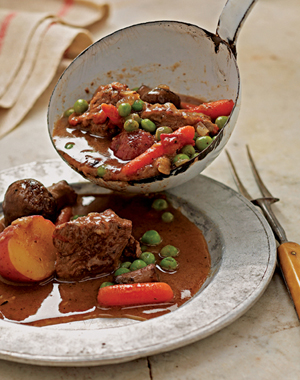
Cancer-fighting, calcium-containing crunch
Prep Time: 10 minutes
Cook Time: None
Ingredients
1 large head Bibb lettuce, washed and chopped into bite-size pieces
1 ounce watercress, thoroughly washed and tough stems removed
½ peeled carrot, sliced into long, paper-thin strips with a vegetable peeler
1 cup (150 g) grape tomatoes
1 tablespoon (15 ml) red wine vinegar
1 tablespoon (15 ml) freshly squeezed lemon juice
1 tablespoon (15 ml) extra virgin olive oil
¼ teaspoon Dijon mustard
¼ teaspoon raw honey
Sprinkling sliced almonds, optional
In a large serving bowl, combine the lettuce, watercress, carrot, and tomatoes.
In a small bowl, whisk the vinegar, lemon juice, oil, mustard, and honey. Pour over the salad. Toss to combine, sprinkle with the almonds, if using, and serve.
Yield: 6 servings
• A quick cool salad, such as this simple Vinaigrette Salad made with basic ingredients, can be the perfect complement to a warming winter one-pot dish.
• You can use the zested lemon from the Venison Stew for the lemon juice in the Vinaigrette Salad.
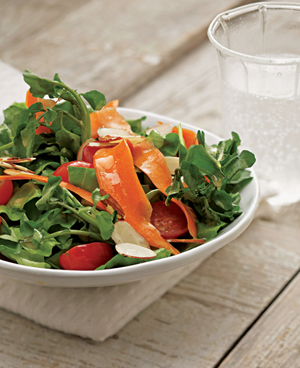
Fiber and protein heavyweights
Prep Time: 15 minutes
Cook Time: 25 minutes
Ingredients
2 teaspoons (10 ml) extra virgin olive oil
½ red onion, finely chopped
2 cloves garlic, minced
1 pound (455 g) leanest hamburger or ground turkey, optional
½ teaspoon liquid smoke
½ teaspoon salt
½ teaspoon ground black pepper
1 teaspoon dried oregano
3 cups (300 g) freshly cooked red beans or two 15-ounce (420-g) cans, rinsed and drained
1 red bell pepper, seeded and chopped
½ jalapeño pepper, seeded and finely chopped, or more to taste
1 large tomato, chopped, or one 15-ounce (455-g) can diced tomatoes, drained (see “Notes from the Kitchen”)
½ cup (120 ml) water
1 tablespoon (16 g) tomato paste
⅓ cup (33 g) Spanish olives, pitted and coarsely chopped
2 tablespoons (17 g) capers
2 cups (340 g) cooked long-grain brown rice
In a 4-quart (4-L) sauté pan, heat the oil over medium heat. Add the onion and garlic and sauté until translucent, about 5 minutes. Add the ground meat and cook until browned, about 5 to 6 minutes. Drain off any excess oil. Add the liquid smoke, salt, pepper, and oregano. Mix the spices into the meat and sauté for 2 minutes. Add the beans, bell pepper, jalapeño pepper, and tomato. Stir in the water and tomato paste. Bring to a simmer and cook for about 15 minutes. Stir in the olives and capers. Fold in the rice and serve.
Yield: 6 to 8 servings (about 10 cups [1700 g])
• The theory of protein combining—the idea that you need to eat, for example, rice and beans together—is now largely discredited. As long as you get all the essential amino acids you need throughout the day, you don’t need to eat them at the same time.
• The only thing missing in this dish is a little more green, so try it with steamed greens or green leafies with a sprinkling of nuts or seeds or a fresh green salad.
• This tasty dish works equally well with red meat, poultry, or as a vegetarian dish with neither!
• Traditional Cajun or Spanish red beans and rice dishes are usually cooked with some kind of ham hock and sausage or bacon. This dish gives you the same smoky flavor without all the poor-quality fat from a tiny amount of natural liquid hickory smoke. Also, the olives and capers give it a kicky flavor zing that more than replaces the richness of the lost meat oils.
• In place of the water and tomato paste, you could use half of the juice from the canned tomatoes or tomato juice.
